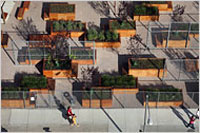 An Art Park Sprouts (for Now) Where New Buildings Were to Grow
An Art Park Sprouts (for Now) Where New Buildings Were to Grow By ERIC KONIGSBERG
Published: September 16, 2009
On Friday morning, in what might be seen as evidence that tough economic times can be good for art, a new 37,000-square-foot outdoor exhibition and performance space will open in Lower Manhattan.
LentSpaceOccupying an irregularly shaped city block at the northwest corner of Canal and Sullivan Streets, it will be both a park and a showcase for established and newer artists, open from 7 a.m. till dusk daily, except in January, February and part of March. Appropriately — given that the lot is on loan for about three years from developers who had hoped to build there by now — the project will be called LentSpace.
Maggie Boepple, the president of the Lower Manhattan Cultural Council, which is running the project, said that it had been in the works since early 2008, but that recent troubles in the real estate market undoubtedly contributed to “the generous length of time” of the loan.
The land is owned by Trinity Church on Wall Street, whose development company, Trinity Real Estate, cleared it of several old buildings a few years ago. Carl Weisbrod, the company’s president, said that when he realized that “the market was not yet ready for a new development here,” he contacted Ms. Boepple to offer use of the lot to the council, which is best known for its efforts to revitalize the arts downtown after 9/11.
In addition to the public spiritedness of the gesture — and to the tax write-off it earned the company — Mr. Weisbrod said Trinity was interested in cultivating the goodwill of the neighborhood, where most of its property is located. (The site is one of several near the Holland Tunnel that the church has owned since 1705, when Queen Anne gave it about 300 acres of farmland along the west side of Manhattan.)
For the last year, with the site shielded from view by a chain-link fence lined with black plastic tarps, workers have been transforming it into a meticulously designed, if rough-hewn, outdoor museum.
Because of a tight budget — Ms. Boepple said she raised about $1 million — and the space’s temporary status, the architects, Interboro Partners of Brooklyn, used inexpensive materials with an impermanent and somewhat industrial feel. The ground was covered in gravel, and benches and planters — holding flowering plants, desert grasses and trees donated by the Parks Department — were built from waterproof plywood.
The architects used the planters and benches to create zones for the park and paths that would steer people crossing it into contact with the artworks.
“There’s a lot of very strict formalism in the park if you want to look for it,” said Adam G. Kleinman, the curator for the Lower Manhattan Cultural Council who will be programming exhibitions and performances in the park.
The eastern edge of the space — abutting a pedestrian stretch of Sullivan Street and a small wedge of park known as Juan Pablo Duarte Square — is bordered by a 215-foot fence made up of independently rotating, eight-foot-wide plywood panels. The panels’ exterior sides are covered with hundreds of small silver and blue aluminum disks, which make the wall glint in the sun like a mirage.
“They use them on oil derricks so that people can see them shine from miles away,” Mr. Kleinman explained, adding that the disks were the idea of Thumb, a graphic design company in Brooklyn. Every three months or so, a different design firm will be commissioned to come up with a project for the fence. (The fence’s blue and silver pattern isn’t random: if you look at it from the right angle, you see that the blue panels are the doors that align with the four main paths through the park.)
Mr. Kleinman will commission three rotating series of artworks: in addition to the fence project, there is also a print series, to be distributed in limited-edition newspapers inside the park and, most notably, a series of installations and sculptures.
The seven sculptural pieces in the inaugural lineup all, in one form or another, incorporate visual puns playing on the conventions of city park design or on the idea of what deserves to be classified as public art.
A small piece by Olga Chernysheva (four models of fences with holes torn in them) is encased in plexiglass and mounted on a plywood column built onto a plywood plinth. Anybody who wants to get a good look at the piece must climb onto the plinth, “so that you’re on display, like a statue you see in a typical park monument,” Mr. Kleinman said.
Other works, by Corban Walker, Ryan Taber, the brothers Oscar Tuazon and Eli Hansen, and Graham Hudson, make use of flagpoles, ladders, climbing wall holds, concrete, steel channels and a fluorescent light bulb.
A piece by Tobias Putrih began as a critique of the unsightly chain-link fence that still surrounds the park. “The management company insisted that the fence was there to stay because it’s private land,” Mr. Putrih said. “But what does it mean to have a fence around public art?”
His work, “Canal/Varick,” consists of seven lengths of chain-link fence
 An Art Park Sprouts (for Now) Where New Buildings Were to Grow
An Art Park Sprouts (for Now) Where New Buildings Were to Grow